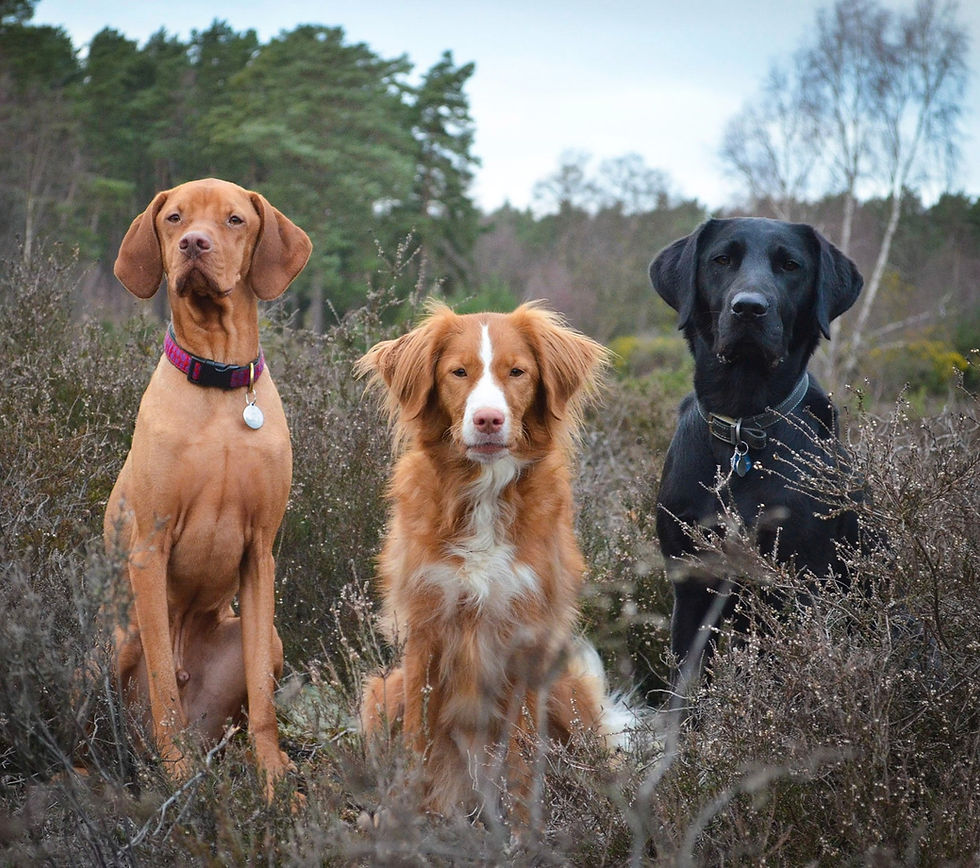Is my dog reactive or aggressive?
- Naomi White

- Aug 22, 2024
- 3 min read
The term ‘reactive dog’ is commonly used in dog training circles but it’s less widely known to many dog owners. What do we mean when we talk about ‘reactive dogs’ or ‘reactivity’? Is it different to an ‘aggressive dog’?
A reactive dog is a dog that overreacts in some situations or to some triggers and takes time to recover afterwards. A dog may be reactive to specific triggers (e.g. people wearing hats or people running), or it can be much broader (e.g. all people).

Reactive behaviour can look different in different dogs, typically we associate it with dogs who are barking and lunging, but it’s not only the overt displays of behaviour which define reactivity. A reactive dog can also run and hide or shut down quietly when faced with triggering scenarios.
The four Fs outline the main forms of reactive behaviours a dog may display:
· Freeze
· Fool Around
· Flight
· Fight
Freeze occurs when a dog chooses to stay still and do nothing, if ignored it may escalate to another reactive behaviour so it’s important to help the dog move away from the trigger as soon as a freeze occurs. This can be a subtle and easily missed reaction, it may also occur just before the dog chooses fight or flight which are easier signs to spot.
Fool Around behaviour can often be mistaken for over-excitement or a happy dog, these dogs may bounce around or play bow, dart back and forth and generally look rather happy. In fact, the dog is overcompensating for the fear they’re experiencing. It’s a coping mechanism to attempt to diffuse the situation, unfortunately these dogs may be told off for messing around which only serves to increase the fear or conflicting emotions they’re experiencing. If your dog jumps up at you frantically when in a busy location, or zooms around crazily when faced with an unfamiliar dog, they may be using these behaviours to cope with the stress or anxiety they are experiencing.
Flight responses occur when the dog chooses to get away from a trigger, they may run or attempt to hide, but usually you will see a freeze just before they try to leave. Dogs will have a ‘flight distance’ – a distance where they feel safe, and if the trigger comes into that space, then the dog will move. If the dog is unable to leave, they are left with no choice but to protect themselves, and this can lead into fear aggression.
The fight response is usually last resort, when all other options have been ignored, a dog will make themselves look as scary as possible to warn the threat away. This is a common cause of on-lead reactivity, the lead prevents the dog from moving away or using other communication methods so they are left with only a fight response to deal with the perceived threat (i.e. barking and lunging).

These responses can be mistaken for aggression but ultimately they are different because reactivity is simply a reaction to a stimulus. Reactive dogs respond to normal stimuli with an abnormal level of intensity. Not all reactive dogs are aggressive, but reactivity can lead to aggression.
When does a reactive dog become an aggressive dog?
Aggression can be defined in different ways but it differs from reactivity in that the dog displays aggression with intent. A reactive dog is attempting to increase the distance from the trigger, while an aggressive dog is looking to decrease the distance. If a reactive dog has all their choices taken away, or all their signals have been ignored, they may display fear aggression in an attempt to make the scary thing go away.
A common example of this is a dog who is fearful of other dogs, they may initially display ‘fool around’ responses and zoom around when other dogs approach, they may also try a ‘flight’ response and run away from other dogs. If other dogs continue to approach and follow them, they may use ‘fight’ behaviours like growling or snapping when dogs start to approach or follow. If these behaviours are repeatedly ignored then the dog may begin to anticipate negative situations when faced with unfamiliar dogs, and this could result in an aggressive response whereby they pre-emptively approach other dogs and attempt to scare them away.
We can help!
If you have experiencing reactive behaviours with your dog, whether it’s a new problem or a long-standing issue, at The Hound Spot we have years of experience working with all manner of reactivity and aggression. Contact us today to find out how we can help you and your dog.




Comments